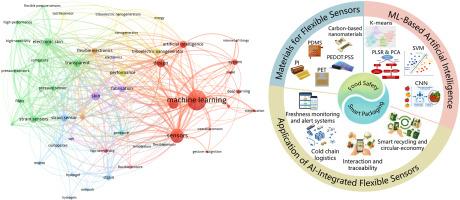From passive to self-aware packs: Flexible Sensor-AI integration powering intelligent, sustainable food packaging
IF 15.4
1区 农林科学
Q1 FOOD SCIENCE & TECHNOLOGY
引用次数: 0
Abstract
Background
The global agri-food sector faces persistent challenges in ensuring food quality, safety, and sustainability. Conventional packaging functions as a passive barrier, incapable of monitoring physicochemical or microbiological changes in real time. This limitation necessitates reliance on conservative expiration dates, thereby contributing to significant food waste. Smart interactive packaging addresses these issues by detecting and communicating the dynamic conditions of food products.
Scope and approach
This review critically assesses flexible sensor materials, including conductive polymers and carbon-based nanomaterials, as well as their integration with wireless communication systems and energy-harvesting technologies. It also evaluates machine learning-driven artificial intelligence (AI) methodologies for freshness scoring and shelf-life prediction. Practical implementations are reviewed through case studies involving sensor patches, embedded films, logistics optimization, and consumer interfaces.
Key findings and conclusions
Flexible sensors enable millimeter-scale monitoring of temperature, humidity, gases, pH, and microbial metabolites, while roll-to-roll printing supports scalable integration into packaging. AI-driven pipelines process multimodal sensor data to generate freshness scores, estimate shelf life, and detect anomalies. These systems employ regression and tree-based models as well as convolutional and recurrent neural networks enhanced by explainable AI techniques. Demonstrations of sensor patches, embedded films, and AI-driven logistics have achieved spoilage reductions. Despite these advances, challenges remained in addressing sensor drift, achieving energy autonomy‒systems capable of operating independently through on-board energy harvesting and management, ensuring material circularity, and meeting regulatory requirements. Future efforts should focus on integrating self-healing materials, improved energy harvesting, biodegradable electronics, and human–computer interaction to realize sustainable autonomous smart packaging systems.

从被动包装到自我感知包装:柔性传感器与人工智能集成为智能、可持续食品包装提供动力
全球农业食品部门在确保食品质量、安全和可持续性方面面临着持续的挑战。传统包装作为一种被动屏障,无法实时监测理化或微生物的变化。这种限制需要依赖保守的保质期,从而导致大量的食物浪费。智能交互式包装通过检测和传达食品的动态条件来解决这些问题。这篇综述批判性地评估了柔性传感器材料,包括导电聚合物和碳基纳米材料,以及它们与无线通信系统和能量收集技术的集成。它还评估了机器学习驱动的人工智能(AI)方法,用于新鲜度评分和保质期预测。通过涉及传感器补丁、嵌入式薄膜、物流优化和消费者接口的案例研究,对实际实施进行了回顾。柔性传感器可实现毫米级温度、湿度、气体、pH值和微生物代谢物的监测,而卷对卷印刷支持可扩展集成到包装中。人工智能驱动的管道处理多模态传感器数据,生成新鲜度评分,估计保质期,并检测异常。这些系统采用回归和基于树的模型,以及可解释的人工智能技术增强的卷积和循环神经网络。传感器贴片、嵌入式薄膜和人工智能驱动物流的演示已经实现了腐败的减少。尽管取得了这些进步,但在解决传感器漂移、实现能够通过车载能量收集和管理独立运行的能量自主系统、确保材料循环以及满足监管要求等方面仍然存在挑战。未来的努力应该集中在整合自修复材料、改进的能量收集、可生物降解的电子产品和人机交互上,以实现可持续的自主智能包装系统。
本文章由计算机程序翻译,如有差异,请以英文原文为准。
求助全文
约1分钟内获得全文
求助全文
来源期刊

Trends in Food Science & Technology
工程技术-食品科技
CiteScore
32.50
自引率
2.60%
发文量
322
审稿时长
37 days
期刊介绍:
Trends in Food Science & Technology is a prestigious international journal that specializes in peer-reviewed articles covering the latest advancements in technology, food science, and human nutrition. It serves as a bridge between specialized primary journals and general trade magazines, providing readable and scientifically rigorous reviews and commentaries on current research developments and their potential applications in the food industry.
Unlike traditional journals, Trends in Food Science & Technology does not publish original research papers. Instead, it focuses on critical and comprehensive reviews to offer valuable insights for professionals in the field. By bringing together cutting-edge research and industry applications, this journal plays a vital role in disseminating knowledge and facilitating advancements in the food science and technology sector.
 求助内容:
求助内容: 应助结果提醒方式:
应助结果提醒方式:


